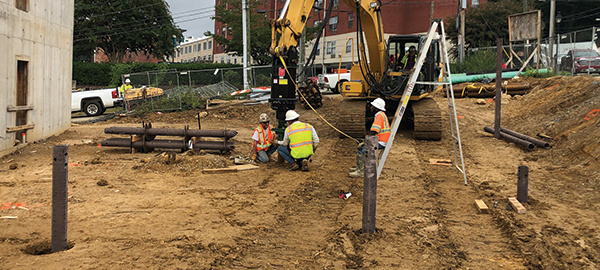Helical piles are a displacement piling system that moves the soil away from the central axis of the shaft. This has many advantages that include no spoils to remove, but also comes with disadvantages as the shaft diameter increases. The helical piling industry categorizes pipe helical piles into low, medium, and high displacement. Each category has advantages and disadvantages that a specifying engineer must consider when selecting a pile that is applicable and economical for the project.
Low Displacement
The largest volume pipe shaft helical pile used in the North American market are low displacement pipe piles. Low displacement piles are defined as piles with central shaft diameters up to 4.5 inches.
These products are used commonly in applications such as new construction, foundation repair, solar, substation, and transmission. The primary advantage is greater structural rigidity due to a higher section properties (compared to square shaft helical piles) that provides lateral resistance of approximately 1 to 6 kips. The higher section properties also increase the shaft buckling resistance in soft soils. Much higher lateral loads can be achieved by battering the piles to transfer a portion of the lateral load to the axial capacity of the pile. Their disadvantage compared to square shaft helical piles is less penetration into firm/hard/dense soils resulting in “spin-out” of the pile. The torque to capacity ratio (Kt) is also reduced as the diameter increases due to the greater volume of soil to displace. Typical Kt for 2.875 to 4.5 inch piles is between 9:1 and 6:1
Ultimate Capacity of Pipe Shaft Helical Piles

- Ultimate capacity of Large Displacement Helical Piles: 300 to 600 kip (1334 to 2669 kN)
- Ultimate capacity of Medium Displacement Helical Piles: 150 to 400 kip (667 to 1780 kN)
- Ultimate capacity of Low Displacement Helical Piles: 63 to 150 kip (280 – 667 kN)
Medium Displacement
Medium displacement pipe shaft helical piles are used in new construction, solar, substation, and transmission applications. Their diameters range from 4.5 to 8 inches. Their axial capacity is typically higher than low displacement piles and their approximate ultimate lateral resistance of 3 to 15 kips is higher than that of low displacement pipe piles. The primary disadvantage is installation costs. Larger equipment, up to 35-ton machines, must be used to achieve the torque and crowd (down force) required to install these piles. Torque to capacity ratios also continue to decrease as the diameter increases. For example, the Kt of a CHANCE® Type RS2875.203 is 9 to 1 and the Kt of a Type RS6625.280 is 5:1. If a specifying engineer is designing for 50 kips ultimate axial capacity, an RS2875.203 will require 5,555 ft-lbs. of torque (50,000 lbs. / 9) but an RS6625.280 would require 10,000 ft-lbs. of torque (50,000 lbs. / 5). This difference in torque required could increase the cost of the project due to need for a larger machine. This is especially true if a larger shaft is not needed to resist lateral loads or for buckling resistance.
Large Displacement
Large Displacement pipe shaft helical piles are typically used in applications that require substantial bending and lateral resistance that low or medium displacement piles cannot achieve. Large displacement piles are defined as piles greater than 8 inches in diameter. These non-stock job specific piles are heavily engineered to meet special loading circumstances. Advantages are high ultimate passive lateral and high axial capacities that are best suited for heavily loaded structures. The disadvantages are a continuation of the previously mentioned for medium displacement piles with increasingly large installation equipment and reduced Kt to the point which standard torque-to-capacity correlations cannot be used for axial capacity verification. The standard design becomes more classic by specifying a minimum embedment depth similar to a drilled shaft.
All three categories of pipe shaft helical piles are used commonly in the North American market today. Hubbell Power Systems, Inc. designs and manufactures all three to service our customers and increasingly demanding projects. The designer is encouraged to use low displacement helical piles as much as possible due to their advantages with torque correlation efficiency and better penetration in dense soil, but the advantages and disadvantages of each must be weighed carefully.

